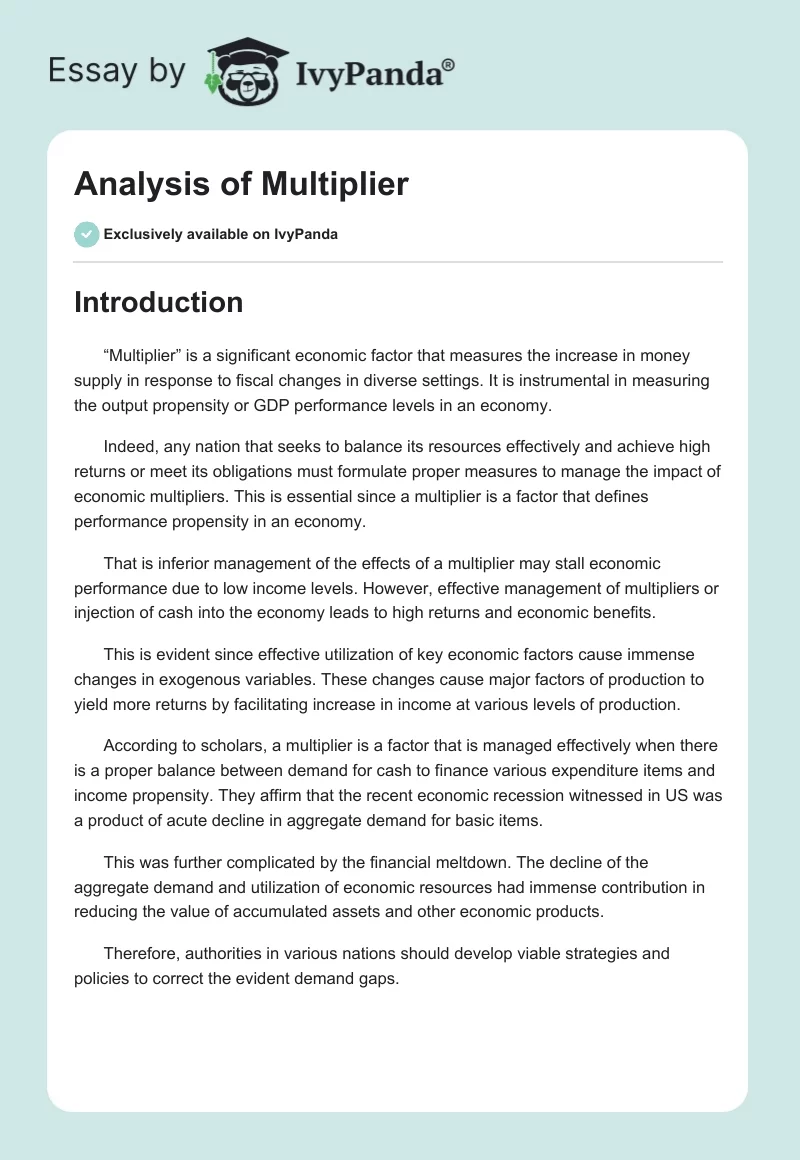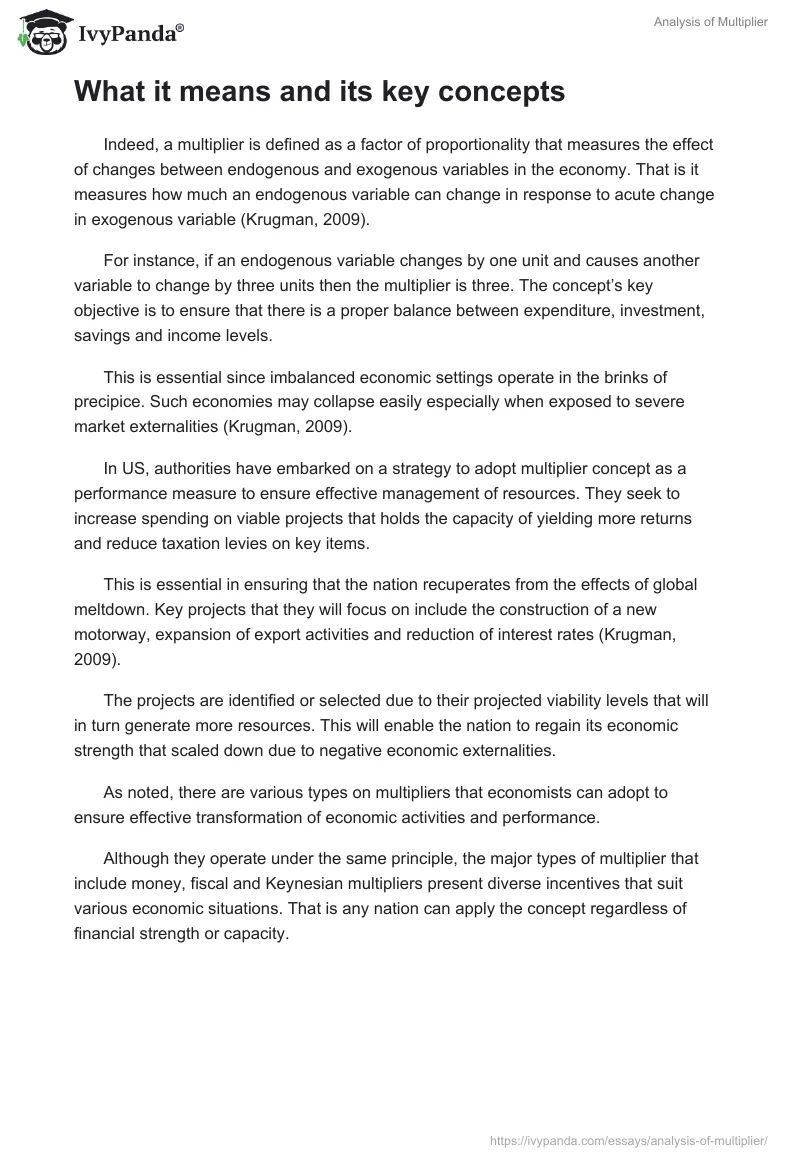Introduction
“Multiplier” is a significant economic factor that measures the increase in money supply in response to fiscal changes in diverse settings. It is instrumental in measuring the output propensity or GDP performance levels in an economy.
Indeed, any nation that seeks to balance its resources effectively and achieve high returns or meet its obligations must formulate proper measures to manage the impact of economic multipliers. This is essential since a multiplier is a factor that defines performance propensity in an economy.
That is inferior management of the effects of a multiplier may stall economic performance due to low income levels. However, effective management of multipliers or injection of cash into the economy leads to high returns and economic benefits.
This is evident since effective utilization of key economic factors cause immense changes in exogenous variables. These changes cause major factors of production to yield more returns by facilitating increase in income at various levels of production.
According to scholars, a multiplier is a factor that is managed effectively when there is a proper balance between demand for cash to finance various expenditure items and income propensity. They affirm that the recent economic recession witnessed in US was a product of acute decline in aggregate demand for basic items.
This was further complicated by the financial meltdown. The decline of the aggregate demand and utilization of economic resources had immense contribution in reducing the value of accumulated assets and other economic products.
Therefore, authorities in various nations should develop viable strategies and policies to correct the evident demand gaps.
What it means and its key concepts
Indeed, a multiplier is defined as a factor of proportionality that measures the effect of changes between endogenous and exogenous variables in the economy. That is it measures how much an endogenous variable can change in response to acute change in exogenous variable (Krugman, 2009).
For instance, if an endogenous variable changes by one unit and causes another variable to change by three units then the multiplier is three. The concept’s key objective is to ensure that there is a proper balance between expenditure, investment, savings and income levels.
This is essential since imbalanced economic settings operate in the brinks of precipice. Such economies may collapse easily especially when exposed to severe market externalities (Krugman, 2009).
In US, authorities have embarked on a strategy to adopt multiplier concept as a performance measure to ensure effective management of resources. They seek to increase spending on viable projects that holds the capacity of yielding more returns and reduce taxation levies on key items.
This is essential in ensuring that the nation recuperates from the effects of global meltdown. Key projects that they will focus on include the construction of a new motorway, expansion of export activities and reduction of interest rates (Krugman, 2009).
The projects are identified or selected due to their projected viability levels that will in turn generate more resources. This will enable the nation to regain its economic strength that scaled down due to negative economic externalities.
As noted, there are various types on multipliers that economists can adopt to ensure effective transformation of economic activities and performance.
Although they operate under the same principle, the major types of multiplier that include money, fiscal and Keynesian multipliers present diverse incentives that suit various economic situations. That is any nation can apply the concept regardless of financial strength or capacity.
The meaning of its size and why its size is important
The size of a multiplier depicts the effect of cash injection or spending into the economy. It shows how well or bad cash and other factors of production are being utilized within the economy.
It also shows the effect of high demand or money supply in response to monetary base factors and variables that control spending (Mooney, 2011). In particular, a higher multiplier in an economy depicts effective utilization of resources that increases income levels.
It gives a clear indication that a nation or an institution is able to increase its spending capacity and reduce tax levies. That is the spending is directed to viable projects that are able to yield high returns that contribute to GDP growth.
Consequently, it shows that there is proper management of aggregate output through effective spending, investment and savings plan. Low multiplier shows that there is acute imbalance between cash injections and expenditure and that the investment made is not able to yield good returns (Mooney, 2011).
Low multipliers are evident in cases where the exogenous changes in spending fail to match the aggregate output. It depicts a decrease in final income that arises from new injection of spending.
Therefore, the size of the multiplier is important since it is the parameter that shows how well a nation or an individual is able to manage its factors of production.
Determinants of its size
Imperatively, the size of the multiplier is dependent on key household variables that inform decision making on issues pertaining to resource utilization. The variables include marginal decision to spend that is known as marginal propensity to consume and decision to save that is referred to as marginal propensity to save.
These variables are significant in determining the liquidity nature of affirm or a nation (Barro, 2012). They show how the proportion of extra income that is received from increased spending is allocated to particular activities such as investment.
Particularly, marginal propensity to spend determines individual’s ability to increase his income levels through investments. Money spent is what generates more income and resources that are vital in achieving sustainability.
This explains why individuals and nations that spend less on various activities generate little income than those whose spending propensity is high.
According to Barro (2012) one can only spend what he has and the higher the expenditure rate the higher the returns. That is more cash injection leads to more income levels that promotes economic sustainability.
This concept has been borrowed by most nations including US whose authorities are keen to increasing expenditure levels. This is set with aim to boost the economic performance through execution on new projects such as building of a new motorway, increasing of exports and reduction of interest rates.
He also stated that higher savings propensity is an ideal strategy for building a stronger financial base. The strategy is significant since it determines that stability of individuals or a nation’s financial flow.
A stable financial flow helps in mitigation of the effects of extreme economic circumstances that are caused due to inferior market externalities (Barro, 2012).
Conclusion
Indeed, a multiplier is a factor that measures how an extra income is spent in an economy to enhance performance levels. It is used in various situations especially incases where new cash injections are made into the economy.
It has been instrumental in establishing income propensity levels of new injections and investments made in various nations.
References
Barro, R. (2012). “Stimulus Spending Keeps Failing,” The Wal.l Street Journal. 20 (23), 244–246.
Krugman, P. (2009). “How Did Economists Get it so Wrong?” New York Times Magazine. Web.
Mooney, C. (2011). “The Science of Why We Don’t Believe in Science,”Mother Jones. Web.


